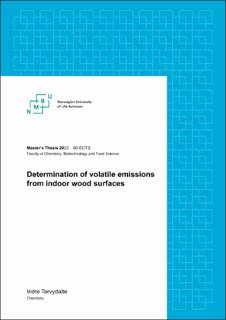| dc.description.abstract | Wood is an important material widely utilised in construction, furniture manufacturing as well as for floor and wall coating in indoor environments. To improve material durability and for preservation purposes, wood materials are often modified with different additives and coatings that can affect indoor air quality (IAQ). Therefore, there was an interest in uncovering if treated wood surfaces emit anthropogenic volatile organic compounds (VOCs) such as xylene, toluene, and ethylbenzene, commonly found in different wood finishes. At the same time, wood naturally emits diverse groups of fatty acid derivatives, aldehydes or/and terpenes that can elevate VOC levels in indoor environments. Hence, the biogenic VOCs such as α-pinene, β-pinene, hexanal, d-limonene, and 3-carene, were quantified to determine the magnitude of the biogenic emissions.
The object of this project was to develop and validate an analytical method suited for the GC-HR-QTOF-TDU system. Acknowledging that VOC emissions from wood are not sufficiently characterised, the project aimed to determine emission profiles based on targeted compound quantification and non-targeted screening of unknown compounds. The project analysed three different Norway spruce samples (Picea abies): untreated interior panel (USP), cross-laminated timber (CLT) and stained interior panel (SSP). The test parameters utilised for this project were based on European Standard NS-EN 16516:2017+A1. The climate chamber method was used to determine the VOCs emitted from the laboratory samples, and the air samples were collected three days after the test specimens were placed in the chambers.
Results for three laboratory samples demonstrated that hexanal had the highest emissions (80.07-3.00µg/m3) followed by α-pinene (45.4-1.9µg/m3), β-pinene (15.4-0.32µg/m3), 3-carene (7.3-0.04µg/m3) and d-limonene (3.9-0.007µg/m3). The concentration of the compounds was highest in the USP and CLT samples. Concentrations of the VOCs were noticeably variating between the duplicates of the same laboratory sample, demonstrating that chambers used for the analysis could have had contamination issues or that variations were caused by the loss of analyte due to insufficient vacuum chamber sealing. Lower concentrations of hexanal and α-pinene were determined in the SSP, suggesting that treating the wood surface can contribute to lower biogenic monoterpene and aldehyde emissions. However, further investigation should be conducted to confirm the assumption.
The Suspect and Non-target screening (SUS and NTS) revealed that alkanes were the most dominant chemical group identified in SSP (29%), CLT (31%) and USP (37%). The most abundant alkanes identified were 2,3-dimethylpentane, 2-methylhexane, methylcyclohexane, 3-metylhexane and heptane. The compounds were not identified in chamber blanks implying that the alkane emissions could be caused by contamination of the sample surface from anthropogenic sources. Terpenes contributed to 7-10% of VOC emissions, and the most abundant terpenes identified were the targeted β-pinene, α-pinene, d-limonene, 3-carene, and non-targeted β-myrcene and o-cymene. Aldehydes contained 5-8% of total VOC emissions in laboratory samples. The most abundant aldehydes identified by the unknown analysis were heptanal, nonanal, decanal, pentanal and targeted hexanal. | |
